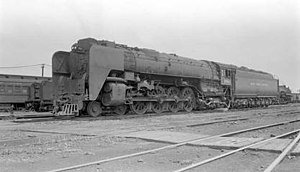NYC Niagara

Niagara #6015 in Indianapolis, Indiana, June 30, 1956, soon before retirement
|
|||||||||||||||||||||||||||||
|
|||||||||||||||||||||||||||||
|
|||||||||||||||||||||||||||||
|
|||||||||||||||||||||||||||||
|
|||||||||||||||||||||||||||||
| Type and origin | |
|---|---|
| Power type | Steam |
| Builder | Alco-Schenectady |
| Build date | 1945–1946 |
| Total produced | 27 |
| Specifications | |
|---|---|
| Configuration | 4-8-4 |
| Gauge | 4 ft 8 1⁄2 in (1,435 mm) |
| Driver dia. | 79 in (2.007 m) |
| Length | 115 ft 5 1⁄2 in (35.19 m) |
| Axle load | 32 long tons (32.5 t) |
| Total weight | 405 long tons (411 t) |
| Fuel type | Coal |
| Fuel capacity | 92,000 lb (42 t) |
| Water cap | 18,000 US gal (68,000 l; 15,000 imp gal) |
| Boiler pressure | 275 psi (1.90 MPa) |
| Cylinders | Two |
| Cylinder size | 25.5 in × 32 in (648 mm × 813 mm) |
| Valve gear | Baker |
| Performance figures | |
|---|---|
| Power output | 6,700 hp (5,000 kW) |
| Tractive effort | 61,570 lbf (273.9 kN) |
| Career | |
|---|---|
| Operators | New York Central Railroad |
| Class | S-1a, S-1b, S-2a |
| Number in class | S-1a (1), S-1b (25); S-2a (1) |
| Numbers | 6000 (S-1a); 6001–6025 (S-1b); 5500 (S-2a) |
| Disposition | All scrapped |
The New York Central Railroad's Niagara was a steam locomotive named after the Niagara River and Falls. It had a wheel arrangement of 4-8-4 in the Whyte notation and is considered as one of the most efficient 4-8-4 ever built.
The first New York Central Railroad Northern (or 4-8-4) was ordered in 1931: #800, an experimental locomotive that had its boiler divided into three sections of different pressure. This was another failed experiment in high pressure steam locomotives.
By the 1940s loads being hauled on the New York Central main line from New York to Chicago were as much as the famous J-class NYC Hudson 4-6-4's could handle. The Chief of Motive Power for the railroad, Paul W. Kiefer, decided to order some 4-8-4's which could sustain 6,000 horsepower (4,500 kW) on the run between the two cities, day after day without respite.
The American Locomotive Company ALCO proposed these locomotives, and although the design owes something to the Union Pacific 4-8-4's, of which Union Pacific 844 is the best-known, the design was actually quite new. Some steam experts have claimed the Niagara to be the ultimate locomotive, as it had the speed of an FEF (the Union Pacific's nickname for their 'four eight fours' was FEF) and the power of Northerns with smaller driver wheels.
The first Niagara was Class S-1a #6000 in 1945; the S-1b (6001-6025) were delivered in 1945-46. The NYC's last steam locomotive was Class S-2 #5500; it had poppet valves. The Niagaras did not have steam domes, as did most steam locomotives, which resulted in a smooth contour along the top of the boiler. A perforated pipe collected steam instead. This was necessary because of the lower loading gauge of the New York Central (15 ft 2 in versus 16 ft 2 in (4.93 m) for other American railroads).
These locomotives had a small water capacity (18,000 US gallons; 68,000 litres) in the tender, because the New York Central was one of the few in North America which used track pans. This allowed a larger coal capacity—46 tons—so the New York to Chicago run could be done with one stop for coal. (The stop was said to be at Wayneport, New York, 14 miles east of Rochester, but that would leave 603 miles to Chicago via the Cleveland lakefront.)
...
Wikipedia
